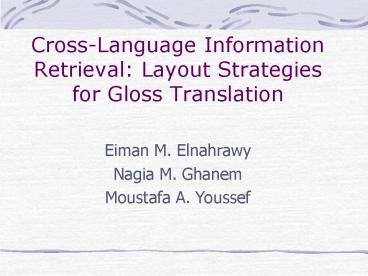CrossLanguage Information Retrieval: Layout Strategies for Gloss Translation - PowerPoint PPT Presentation
1 / 20
Title:
CrossLanguage Information Retrieval: Layout Strategies for Gloss Translation
Description:
Cross-Language Information Retrieval: Layout Strategies for ... of Maryland Translingual Information Retrieval System' ... The experiment was conducted ... – PowerPoint PPT presentation
Number of Views:43
Avg rating:3.0/5.0
Title: CrossLanguage Information Retrieval: Layout Strategies for Gloss Translation
1
Cross-Language Information Retrieval Layout
Strategies for Gloss Translation
Eiman M. Elnahrawy Nagia M. Ghanem Moustafa A.
Youssef
2
Goal
- In University of Maryland Translingual
Information Retrieval System - The three most common translations for each word
are displayed - Using this gloss translation, users can assess
whether the document is relevant or not - In our experiment
- We studied the effect of changing the number of
translations on the users assessment
3
Variables
- Independent Variables
- The number of displayed translations per word.We
have 3 treatments 2,3 or 4 translations. (1x3
experiment) - Dependent Variables
- The percentage of documents that the user could
take a decision within a fixed period of time - Precision measured using non-relevant documents
the fraction of the selected documents that are
non-relevant (fallout) - Recall measured using non-relevant documents the
fraction of the non-relevant documents that are
selected - User Satisfaction
4
Hypotheses
- Hypothesis 1 Increasing the number of displayed
translations per word will decrease the
percentage of documents that the user can take a
decision within a fixed period of time - Hypothesis 2 Increasing the number of displayed
translations per word will improve the users
assessment - We expected that users will prefer fewer
translations per word
5
Subjects
- Eighteen subjects (14 males, 4 females)
- All subjects were students at the UMD (15 grad.,
3 undergrad.) - The majority were Computer Science students, the
others were Electrical, Mechanical, and Computer
Engineering students - The experiment was conducted within subjects
- To minimize the effect of getting used to the
system on the user performance - We had 3 treatments that can be permuted in 6
different ways and 18 subjects - We assigned 3 subjects to each one of the 6
permutations
6
Results
- The number of documents that each subject was
able to judge their relevance within the allowed
five minutes were recorded. - We measured the Fallout and the non-relevance
Recall. - The single factor analysis of variance (ANOVA)
showed that there were no statistically
significant differences at Alpha 0.05.
7
Results
- The percentage of documents the user could make a
decision
8
Results
- Fallout
9
Results
- Non-relevance Recall
10
Results
- Subjective Satisfaction
11
Results
- We were interested in the subjects responses for
the following five questions - Overall Reaction to the System (1Difficult --
9Easy) - Overall Reaction to the System (1Frustrating --
9Satisfying) - Overall System Efficiency (1Efficient --
9Inefficient) - Screen Layout were Helpful (1Never -- 9Always)
- Learning to Operate the System (1Difficult --
9Easy)
12
Results
13
Results
14
Results
15
Discussion
- Number of documents in which the user took a
decision - Large Variance? Decision on the title or the
entire document - Fallout and non-Relevance Recall
- Decision based on bold and red words
- Better selection of the document collection
- Satisfaction
- 83 of the users preferred one or two
translations per word
16
Observations
- The order in which the subject takes the
treatments is important - Most users performed better on second and third
treatments than on the first one - Long loading time of the whole document web
page - Some subjects used only the title or judged the
relevance as do not know
17
Conclusions
- Impact for practitioners
- Users prefer two translations per word
- The title should be formatted in a way that
facilitates users decision - The time it takes the system to format the
document should be reduced
18
Conclusions (continued)
- Suggestions for future researchers
- Working on the entire document collection or
selecting a better subset - Other measures of user performance can be used
- Adding a fourth option, not seen
- Other layout strategies such as vertical vs.
horizontal layout
19
Acknowledgement
- Thanks to
- Dr. Ben Shneiderman
- Dr. Doug Oard
- Clara Cabezas
- Gina Levow
- Pilot subjects
- Subjects
20
Thank You































